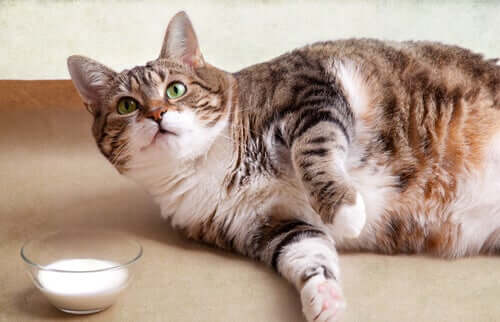The Signs of a Healthy Cat


Written and verified by the biologist Paloma de los Milagros
Going to the vet frequently is a good way to make sure you have a healthy cat. But there are also some basic signs that can help you figure out if your cat is healthy without having to leave your home.
Because of their introverted nature, health problems often go unnoticed in cats. The big issue with that is that you may diagnose a problem too late. With some diseases, catching it early is the key to successful treatment. This is why it’s so important to be aware of some of the physical and behavioral signs that a cat is healthy or unhealthy.
Healthy cat signs: our tips
Physical examination
Before you do a thorough examination of your cat’s body, you can start with a more general examination. But you’ll want to avoid it tensing up, so you need to choose your moment wisely. When you’re together on the couch is a good option. Without making any sudden movements, slowly run your hands along its body, applying a little bit of pressure.
If it shows discomfort in any place in particular, or you notice any bumps or other skin issues, then that could be a sign of a health problem. If any of these things is the case, take it to the vet to get a more thorough check-up.
On the other hand, if you don’t notice any issues after this general inspection, you can start to examine these areas:
- Eyes: a cat should have clear, shiny eyes without any secretions. Its pupils should also respond quickly to changes in light.
- Ears: a bit of wax is normal, but its ears should still be clean, dry, and free of any irritations or rashes. Any unpleasant smell or pus is a sign that it may have an infection.
- Mouth: the signs that a cat is healthy in this area are pink gums and a total absence of sores or wounds in the mouth. We also recommend doing frequent plaque cleanings to make sure its teeth stay as healthy as possible.
- Fur: a cat’s fur should be as shiny and thick as it’s normally based on its breed and the time of year.
- Weight: being over or underweight is definitely a sign of a potential health problem in cats. If this is the the case, then take it to your vet.

Behavioral signs that a cat is healthy
Cats are animals with strict routines. That means that any minor change to its habits could actually be a symptom of pain, or some other health problem. Here are some of the main things to watch out for:
- Appetite: pay attention to how often, and how much, your cat eats–this is important in order to make sure that it’s healthy. Most cats will start to eat less when they’re sick. That will have a direct impact on their weight. You should also monitor how much water yours drinks every day. That’s key to its hydration and general well-being.
- Activity levels: like humans, sick animals will also tend to be lazy and lethargic. So, if you notice yours being unusually inactive, you should take it to the vet. Cats are independent, but they’re also curious, active, and playful. So, if you’re not seeing that behavior in yours, it may be a sign of an illness.
- Hygiene habits: you should also be paying attention to the frequency and quality of your cat’s pees and poops. On a side note, if your cat is starting to do its business outside the litter box, don’t yell at it. Get advice from a professional and see what you can do to fix that.

In general, active behavior, a good overall mood, and a positive physical appearance are all indicators of good health. If you want to be able to make sure your cat is healthy from your home, you’ll need to have a deep understanding of its personality and normal appearance. But never let that totally replace check-ups at the vet.
All cited sources were thoroughly reviewed by our team to ensure their quality, reliability, currency, and validity. The bibliography of this article was considered reliable and of academic or scientific accuracy.
- Hill´s. (2019). Common Signs of a Healthy Cat. Recuperado de https://www.hillspet.com/cat-care/behavior-appearance/signs-of-healthy-cat
- King, I. (2018). The Conscious Cat. How to Perform a Home Health Check for Your Cat. Recuperado de https://consciouscat.net/2018/11/05/how-to-perform-a-home-health-check-for-your-cat/
This text is provided for informational purposes only and does not replace consultation with a professional. If in doubt, consult your specialist.